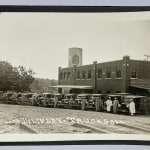Heeney Studio
Album Showing the Crocker Packing Co. of Joplin, MO, 1932
Photo album; silver prints (21)
Each 5 x 7 inches
With title in negative.
One with photographer's credit in negative as well.
With title in negative.
One with photographer's credit in negative as well.
Further images
-
(View a larger image of thumbnail 1
)

-
(View a larger image of thumbnail 2
)

-
(View a larger image of thumbnail 3
)

-
(View a larger image of thumbnail 4
)

-
(View a larger image of thumbnail 5
)

-
(View a larger image of thumbnail 6
)

-
(View a larger image of thumbnail 7
)

-
(View a larger image of thumbnail 8
)

This 1932 presentation album shows the Crocker Packing Plant of Joplin, MO, which opened its doors in 1913 (a second location opened in Okmulgee, OK, in 1931). Present in the...
This 1932 presentation album shows the Crocker Packing Plant of Joplin, MO, which opened its doors in 1913 (a second location opened in Okmulgee, OK, in 1931). Present in the album are photographs of the owner John L. Crocker, the delivery trucks with their drivers, the traveling salesmen, the main office and billing, the laundry room, the various coolers, a U.S. Government inspection, and the processing rooms such as the picking room, the sausage room and others. There are portraits of employees posed proudly beside a carcass (or several) in colorfully-monikered locales like the killing floor or pork-gutting room. There is also an image of the plant's baseball team, the Crocker Cardinals.
Cardinals are a motif throughout this album. One can be seen on the tower outside the factory, part of the Crocker Packing Co. logo, and a hung up jumpsuit in the factory laundry reads “Cardinal Brands” on the back. We were unable to find any information about Cardinal Brands, and whether it was specific to Crocker Packing or a larger network of food distributors.
Meat packing exploded in the United States from the mid-1860s on. The expansion of rail, the invention of refrigeration, and the unprecedented scale of cattle ranching made possible by the westward expansion of the United States into Oklahoma and the great plains, all made a previously unimaginable scale possible. Kansas City, MO became the center of the American meatpacking industry, which accounted for as much as 91% of the city’s industrial outcome by 1901 (“Making Meat: Race, Labor, and the Kansas City Stockyards,” John Herron, The Pendergast Years).
The photographs were taken by a commercial photographer identified as Heeney, who operated at 612 1/2 Main Street in Joplin.
Cardinals are a motif throughout this album. One can be seen on the tower outside the factory, part of the Crocker Packing Co. logo, and a hung up jumpsuit in the factory laundry reads “Cardinal Brands” on the back. We were unable to find any information about Cardinal Brands, and whether it was specific to Crocker Packing or a larger network of food distributors.
Meat packing exploded in the United States from the mid-1860s on. The expansion of rail, the invention of refrigeration, and the unprecedented scale of cattle ranching made possible by the westward expansion of the United States into Oklahoma and the great plains, all made a previously unimaginable scale possible. Kansas City, MO became the center of the American meatpacking industry, which accounted for as much as 91% of the city’s industrial outcome by 1901 (“Making Meat: Race, Labor, and the Kansas City Stockyards,” John Herron, The Pendergast Years).
The photographs were taken by a commercial photographer identified as Heeney, who operated at 612 1/2 Main Street in Joplin.







